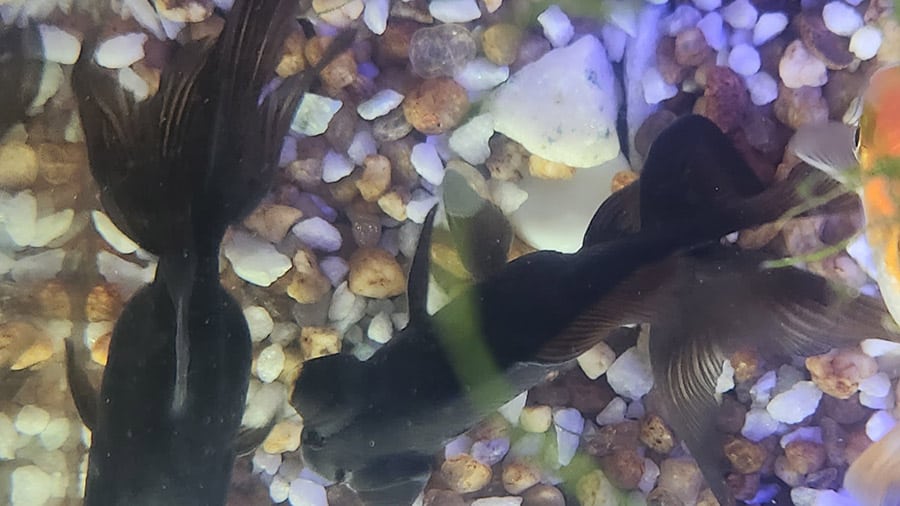How Do I Know If I Have A Male Or Female Goldfish?
So, if you are looking to have more fish babies in your aquarium or pond and want to start small and only buy a few fish for a start, here, I have included some information to help you determine whether the fish you got at the shop is likely a male or a female.
Although these methods aren’t foolproof, they will at least give you a better chance of knowing. Remember that the younger the fish, the harder it will be to determine.

Male Goldfish
Male goldfish usually look like they haven’t been visiting takeaway places very often, meaning their bodies appear slimmer, especially around the tummy and tail area. This can easily be seen by looking from the top.
You can also have a look at their anal openings (sometimes you can spot “the spot” after a while of looking through your fish tank glass). This will appear like an oval-shaped innie; it will become easier to spot once you identify what the female “spot” looks like. The anal openings are usually referred to as the vent of the fish.
This is not always a great method on its own, so do accompany the “spot” check with the rest of the things to look out for.
Male goldfish also usually have longer, pointier dorsal, pectoral, and anal fin tips compared to the females of the same species. The dorsal fin is located on the top back of the fish between the head and the tail.
Once the male fish has reached sexual maturity (depending on the quality of life, it can be anything from a year) and is ready to start spawning, you will be able to see white spots like pimples form on their gill covers, bottom fins or scales called breeding stars. Here, you can tell who is who in the aquarium.
Talking about spots, should you see white spots on fish around the body and gills of your fish and see symptoms like loss of appetite, lethargy, or their gills working harder than usual? It is best to investigate and start treatment for this parasite, Ich, or the white spot disease, found in freshwater fish. If left untreated, this can be deadly to your fish, so it is best to look out for this highly contagious parasite.
The males at the three-year mark are the best for breeding as sexual maturity has reached its peak, so it’s always a good idea to write down when you got which fish and at what age you got the fish just to roughly be able to work out the age for breeding purposes.
Female Goldfish

Female goldfish are rounder or fatter around their tummy area and appear smaller or shorter compared to the same-age male species. You can see the difference between your fish when you view them from the top of your tank.
The anal opening of the female fish will usually be a bit rounder and would protrude a little. Once you have seen the rounder “spot” on the female, it will be easier to see the difference between the male and female goldfish. The protruding “spot” is usually only seen around or closer to breeding time, so this method can be used when the fish is a little bit older (closer to the one-year mark).
As I mentioned before, it is best to combine all these methods, as just testing the theory with one might lead you in the wrong direction.
The female goldfish usually has a shorter, rounder, or curved dorsal, pectoral, and anal fin tip. The female goldfish will also appear to be brighter in color compared to the male goldfish, so look out for the fish that appear to be a bit duller in color and apply the other methods to ensure it is a male or female.
My fantail female started with very dull colors and just some spots, only once she started laying eggs (around the one-year mark) did her colors fully develop. She now has red, orange, and black spots all over her white body. Another name for this color combination is “calico”, which is the tri-color combination of black, orange, and white.
Before female goldfish spawn, the female stomach area will pop out even further as they carry their eggs on the sides of their tummy area.
Monitor your fish if their tummies or any other part starts enlarging suddenly. If you see their scales starting to point outwards (pine cone appearance) and your goldfish isn’t a Pearscale goldfish, then you immediately need to quarantine and start treatment for potential dropsy.
Conclusion
Using the methods mentioned, you should be able to tell the difference between a male and a female fish. Although it is much harder to sex fish when they are young, it will get easier the older they get. Practice makes perfect, and you can spot these differences easily in no time.
